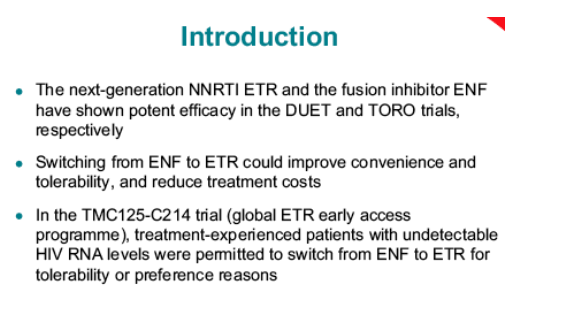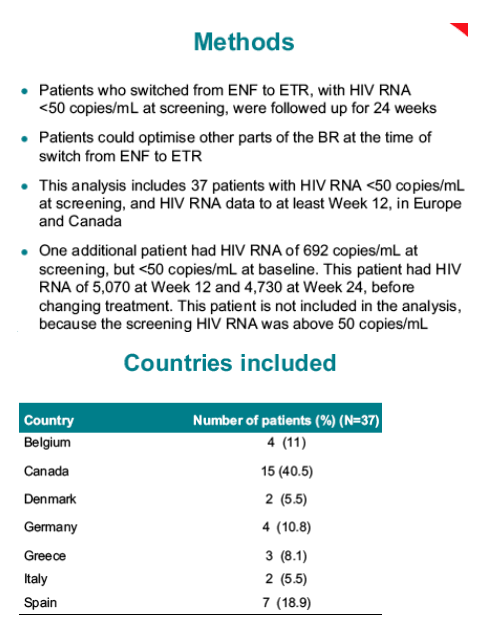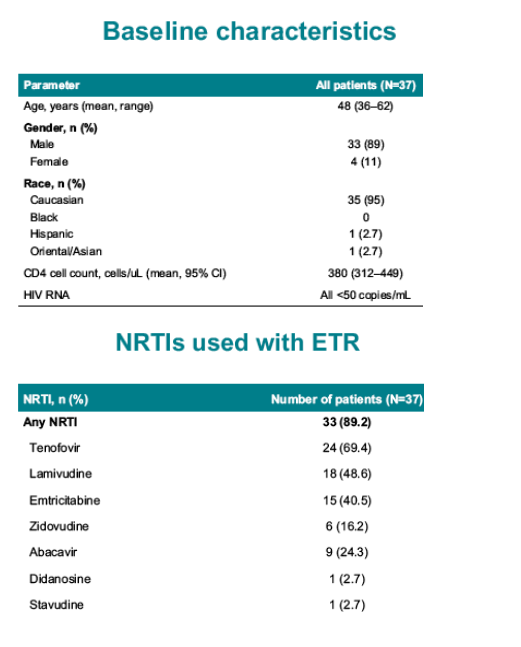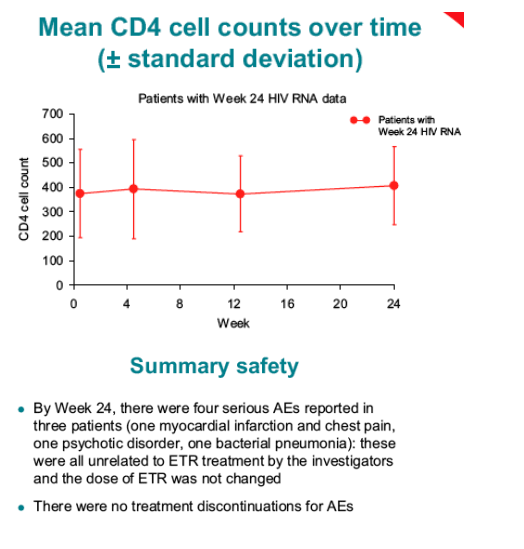 |
 |
 |
| |
Switching from enfuvirtide to etravirine -
efficacy results from the etravirine early access programme
|
| |
| |
Reported by Jules Levin
9th International Congress on Drug Therapy in HIV Infection, Glasgow, UK, 9-13
November 2008
Esteban Ribera,1 Mona Loutfy,2 Eric Florence,3 Stephane De Wit,4 Antonella Castagna,5 Bob Ryan,6 Andrew Hill,7 Stephan Marks8
1Hopital Vall d'Hebron, Barcelona, Spain; 2Maple Leaf Medical Clinic, Toronto, Canada; 3Prince Leopold Institute of Tropical Medicine, Antwerp, Belgium;
4St Pierre University Hospital, Brussels, Belgium; 5Department of Infectious Diseases/RCCS, Fondazione San Raffaele del Monte Tabor, Milan, Italy;
6Tibotec Inc., Yardley, PA, USA; 7University of Liverpool, Liverpool, UK and Tibotec BVBA, Mechelen, Belgium; 8Janssen-Cilag B.V., Tilburg, The Netherlands
AUTHOR CONCLUSIONs
In the early access programme in Europe and Canada, 37 patients with HIV RNA <50 copies/mL at screening switched from ENF to ETR. These patients also used DRV/r (n=36), raltegravir (n=23), maraviroc (n=6) and NRTIs (n=33)
In the observed data analysis, HIV RNA was <50 copies/mL for 32/37 (86%) patients at Week 12, 35/37 (95%) patients at Week 24. CD4 cell counts remained stable during follow-up
ETR may be an effective substitute for injectable ENF, for reasons of intolerance or patient preference.
Further investigation of this approach is warranted
Abstract
The next-generation NNRTI etravirine (ETR; TMC125) and the fusion inhibitor enfuvirtide (ENF) have shown strong efficacy in the DUET and TORO trials, respectively. Switching from ENF to ETR could improve convenience and tolerability, and reduce treatment costs. In the TMC125-C214 trial (global ETR expanded access programme), treatment-experienced patients with undetectable HIV RNA levels were permitted to switch from ENF to ETR.
Patients who switched from ENF to ETR, with screening HIV RNA <50 copies/mL, were followed up for 24 weeks. Data were analysed for patients in Europe and Canada. Patients could optimise other parts of the background
regimen (BR) at the time of switch from ENF to ETR. Overall, there were 37 patients switching from ENF to ETR in Europe (n=22) and Canada (n=15). Of these, 11% were female, 95% were Caucasian, with a mean age of 48 years. The baseline median CD4 cell count was 380 cells/uL (95% confidence interval [CI]: 312-449). Within this study, 36 of the 37 patients (97%) used darunavir with low-dose ritonavir (DRV/r) in the BR, with raltegravir used in 62%, maraviroc in 16%, and NRTIs for 89%. The percentage of patients with HIV RNA suppressed below 50 copies/mL was 83% at Week 4, 86% at Week 12 and 95% at Week 24. Of those with HIV RNA not <50 copies/mL at Week 12, there were five HIV RNA levels just above the detection limit (50, 52, 52, 58 and 217 copies/mL). One additional patient had HIV RNA of 692 copies/mL at screening, but <50 copies/mL at baseline. This patient had HIV RNA of 5,070 at Week 12 and 4,730 at Week 24, before changing treatment. This patient is not included in the analysis, because the screening HIV RNA was >50 copies/mL. There were four serious adverse events (AEs) reported: these were all unrelated to ETR treatment by the investigators and the dose of ETR was not changed.
The vast majority of patients who switched from ENF to ETR have sustained HIV RNA suppression <50 copies/mL for up to 24 weeks of study, with stable or rising CD4 cell counts.





|
| |
|
 |
 |
|
|